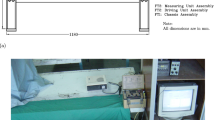Abstract
In order to gain a better understanding of matrix-controlled fatigue failure processes in non-metallic materials a series of fatigue tests were performed on several different polymer materials representing different classes of mechanical response. Fatigue crack propagation rates between 5×10−6 in. cycle−1 (127 nm cycle−1) and 4×10−4 in. cycle−1 (10 300 nm cycle−1) were measured in nylon, polycarbonate, ABS resin, low-density polyethylene and polymethyl methacrylate. A strong correlation was found between the fatigue crack propagation rate and the stress intensity factor range prevailing at the advancing crack tip. Whereas metals exhibit comparable fatigue growth rates for a given stress intensity range when normalised with respect to their static elastic modulus, the polymer materials exhibited a 1300-fold difference in crack growth rate for a given normalised stress intensity range. This observation dramatically illustrates the importance of understanding molecular motion and energy dissipation processes in polymer materials as related to their chemistry and architecture. The relative behaviour of the different polymer materials could be generally correlated with their reported damping characteristics.
Similar content being viewed by others
References
K. E. Hofer Jr andE. M. Olsen, Technical Report AD 652.415, April 1967.
R. F. Boyer,Polymer Eng. and Sci. 8 (1968) 161.
J. Heijboer,J. Polymer Sci. 5 (1967) 3755.
S. G. Turley,Polymer Preprints, American Chemical Society8 (1968) 1524.
E. H. Andrews, “Fracture in Polymers” (American Elsevier Publishing Company, New York, 1968).
Modern Plastics Encyclopedia (McGraw-Hill Inc., New York, 1968).
N. H. Watts andD. J. Burns,Polymer Eng. and Sci. 1 (1967) 90.
T. K. Kwei,J. Polymer Sci. 4 (1966) 943.
A. E. Woodward, J. A. Sauer, C. W. Deeley, andD. E. Kline,J. Colloid Sci. 12 (1957) 363.
M. P. Groenewege et al, in “Crystalline Olefin Polymers”, edited by M. Raff and A. Doak, “High Polymers”, vol. XX (Interscience Publishers, New York, 1965).
A. V. Tobolsky, “Properties and Structure of Polymers” (Interscience Publishers, New York, 1960).
F. R. Mcgarry andA. M. Willner, MIT Research Report R68-8, March 1968.
J. A. Brydson, “Plastic Materials” (D. van Nostrand Company Inc., Princeton, NJ, 1966).
P. C. Paris andF. Erdogan, ASME Paper 62-WA-234, 1963.
S. Pearson,Nature 211 (1966) 1077.
Y. Katz, P. L. Key, andE. R. Parker,Trans. ASME Ser. D90 (1968) 622.
“Fracture Processes in Polymeric Solids”, edited by B. Rosen (John Wiley and Sons Inc., New York, 1964).
F. R. Eirich,J. Appl. Polymer Sci. 4 (1961) 1.
Author information
Authors and Affiliations
Rights and permissions
About this article
Cite this article
Hertzberg, R.W., Nordberg, H. & Manson, J.A. Fatigue crack propagation in polymeric materials. J Mater Sci 5, 521–526 (1970). https://doi.org/10.1007/BF00556040
Received:
Accepted:
Issue Date:
DOI: https://doi.org/10.1007/BF00556040




